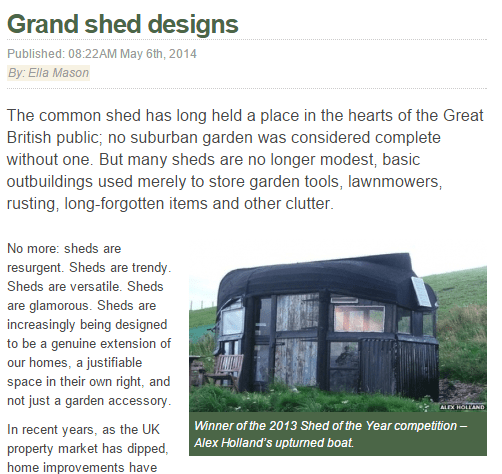How and why we should move on from "Content is King"
"Content is King"... That phrase has been used so often over the years that it has become something of a mantra and a well-worn one at that. That doesn't make it any less relevant than it was at the time or that we should lose sight of its meaning - which is that content will always, and should always, carry great significance.
In case you're wondering, Bill Gates coined the phrase 'Content is King' - it was the title of an essay he wrote back in January 1996. 'One of the exciting things about the Internet is that anyone with a PC and a modem can publish whatever content they can create,' mused the co-founder of Microsoft, over 18 years ago.
And Gates was right. As a journalist at the beginning of my career in 1996, I recall the distant rumblings of panic when as the size and scope, and sheer reach, of the internet became apparent. Getting published suddenly became a lot more achievable, for all. Suddenly, everyone and anyone could find their voice and write; and be published.
There was now stuff to read online. Free stuff. What would that mean for the stuff we wrote, printed, and charged for, and ultimately, what would the future bring for us journalists? Was there a place in the digital world for those of us who valued prose, structure, and storytelling, and genuinely readable content, over SEO and keywords?
In 2014 those fears have been allayed to a certain extent. Print media may have been compromised, marginalised and challenged but content is as valued as ever. Good content, that is. Nothing has changed in this regard. Entertaining, informative and emotive content is read, shared, sought after and appreciated.
Creating this content is at the very heart of what we do at Zazzle Media. Previous posts, written by my colleagues for Smart Insights, have looked at our ideation process; how we leverage data from social likes and shares to help inform audience understanding and create personas, and how we then take that knowledge to produce a content strategy for our growing roster of clients.
Now we'll focus on actually writing that content and how myself and the rest of the Content Team produce guest posts, articles, blogs and features which are regularly placed on high-ranking websites and keep our clients happy, and reassured that we are delivering to their expectations.
I'll talk you through a few examples of content published in recent months and how we created these articles; all of which were written on behalf of clients operating in niche business sectors. The conclusion I hope you reach is that, no matter how 'limited' the potential of the content may appear to be on paper, you can create appealing articles which transcend what might have started out as rather dry subject matter.
Just before we look at this in depth, however, I'd like to again stress the critical role of the headline. This is a subject I addressed at length in one of my recent blogs for Zazzle - you can read that piece in full by 'nailing the perfect headline'.
If you work in content creation and relegate your focus on the headline as an afterthought, I urge you to reconsider your approach. The headline to an article is the gateway to the main piece and if it doesn't convert the casual browser to reader then you might argue that whatever you've just written - be it 500, 1,000 or 2,000 words long - may have been one wasted endeavour. Heartbreakingly harsh but true.
Successful content case studies
Now, let's take a look at these content case studies.
People are powerful, and their words can not only help to shape an article but become the driving force behind it. This was certainly the case when I wrote a feature on behalf of a client in the hearing health industry who wanted to share its support for a charity called Music and the Deaf. As soon as it had been established that the charity were able to make available a series of video diaries, recorded by some its younger musicians, the feature took shape. After making further queries we learned that Music and Deaf's general manager had a 20-year relationship with the charity and, profoundly deaf since birth, it was obvious he not only had a wonderful story to tell but was happy and proud to share it.
To emphasise the strength of his journey, we opened the feature in the subject's own words; presented in the first person, honest and inspirational, it set the scene perfectly:
'Music became an emotional outlet for me since I was eight years old. I found it so difficult to socialise with my peers; I’d started to become withdrawn. But playing the piano seemed to help fill this gap. Performing in public helped me to overcome my nervousness and raise my self esteem. It helped to challenge audiences into thinking that deaf people too CAN become musicians. I played in brass bands, orchestras and ensembles, so I overcame that fear of communicating with others. I don’t think I’d be as confident as I am now without music.'
It was a reasonably easy feature for our PR team to place and you can read the full article.
It's also a prime example of why it's sometimes justifiable to dispense with a conventional introduction and literally let someone's words speak for themselves.
When news is trending and topical it can pay to be reactive and examine how you might be able to align an item of content with an agenda. Two examples of our recent work spring immediately to mind.
1. When it was announced that the Football Association was going to lose £1.6 million of investment directly because of a reduction in the number of people playing the sport, it was a relatively seamless leap to put together a thought piece on grassroots football, tying in a sports equipment supplier.
2. On a similar note, the countdown to the London Marathon provided the opportunity to create a preview of one of the world's iconic sporting events, recounting not only past triumphs and tragedies but the novelty side of the race - those brave souls who run in weird and wonderful costumes. The marathon is a key date in the sporting calendar and also a major focal point for one of our clients.
Content with authority always has value. Presenting an article which has input from an expert in a particular field elevates it above what might otherwise be a one-sided irrational rant. When approaching a piece about road rage for a black box insurance company, it would have a straightforward task to bash out a sensationalist tone, citing some of the many headline-grabbing incidents of recent years.
Instead, an interview with a psychologist, specialising in driver behaviour, gave the finished product a sense of gravitas and was well received by a leading motoring website.
- Don't be afraid of controversy
Within the boundaries of reason and good taste there is no need to shy away from controversy. Clearly, sound editorial judgement needs to be applied, particularly when you are effectively writing for a brand, but a sensibly constructed, well balanced post addressing a hot topic can help your content fly.
The example here was a feature-length article tapping into a subject which has been the cause of debate for several months and will continue to divide opinion and invoke comment for much longer. The piece, on e-cigarettes, was published by the Telegraph.
Data and statistic-led articles will always generate interest, especially if there's a headline-grabbing figure involved. Statistics provide a base with which to wrap content around.
A survey of 1,000 young drivers, conducted by one of Zazzle's clients, triggered interesting results, not least that 50% of them read text messages while driving - which is highly dangerous and a growing problem among motorists.
Accompanying the main article, which was posted by MSN Cars UK, was a visually striking infographic detailing the biggest distractions for young drivers. Together, it was a strong and attractive package, good enough for one of the UK's most respected motoring sites to snap it up.
Not every item of content needs to include an emotionally-charged interview or angle on a hard news story. There is always a place in the digital world for humour and content of a more light-hearted nature; don't forget that words and images which make readers laugh are hugely shareable.
When creating a relevant piece for a client on the gardening trade, we focused on one of the newest and funniest trends in the niche. Garden shed design. It was a lot of fun to research and write, and coincided neatly with the countdown to the 2014 Shed of the Year competition.

Source: http://www.kitchengarden.co.uk/news/grand-shed-designs
The timing was deliberate, of course.
Not everything goes to plan and on many occasions I've been confronted by a situation where my original synopsis for a feature has collapsed around my ears, and I've been forced to rethink my strategy. This is very often because an interview has fallen through, not gone as well as expected, or that supporting material has either simply not been strong enough, or been located.
Don't despair. Instead, consider the new direction you can take the article and, at this stage, by all means call on other members of your team for fresh ideas.
A useful example here would be a feature article I was crafting for a client in the storage business. Originally conceived as a focus on some of the weirdest items stored by customers, it quickly became clear that sourcing enough examples to support a credible feature was an issue.
Instead, we switched focus and drafted a piece on start-up businesses using a case study from the company and finding two further individuals to interview - a local micro brewery and a gourmet popcorn maker.
By selecting slightly unusual niche businesses to include, we achieved a feature which had an inspirational slant, reaching out to those people harbouring dreams and ambitions of turning their hobby into their livelihood. It worked as a small business success stories piece.
Creating winning content isn't easy - it takes work, practice, experience and, as we have already covered, several stages of data-informed research to ensure that what we are producing is specific to our target audiences.
But following the process we have fine-tuned at Zazzle means that, by the time the tasks are assigned to myself and my team, we already have a very clear idea of what we are expected to produce, and why, and how to go about that, instead of a large blank page (or screen).
By using some of the approaches and methods I've detail in this article, you can see how we've achieved our goal - of fashioning sought-after content which leading websites are happy to publish, even though many of them have in-house teams of writers themselves.

Thanks to
Kevin Hughes for sharing his advice and opinions in this post. Kevin is Content Manager at
Zazzle Media , a data-informed content-led digital marketing agency. An experienced journalist and writer, he has previously held senior editorial positions in the sports magazine market. He also blogs regularly for ESPN. You can follow him on
Twitter or connect on
LinkedIn.




 Thanks to
Thanks to 


